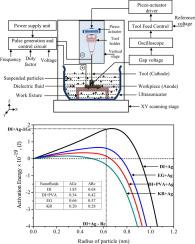Advanced Powder Technology ( IF 4.2 ) Pub Date : 2020-09-02 , DOI: 10.1016/j.apt.2020.08.010 Ishwar Bhiradi , Somashekhar S. Hiremath

|
In the present work, silver nanoparticles (AgNPs) are generated using the Micro-Electro Discharge Machining process (micro-EDM). Nanofluids are synthesised in dielectric fluids such as polar fluid like Deionized water (DI), Deionized water with 4 wt% of Poly-Vinyl Alcohol (DI + PVA), and non-polar fluids like Ethylene Glycol (EG) and Kerosene (KR). Low energy consumption, in-situ nanofluid synthesis, cleaner work environment, non-essential chemical post-processing during the synthesis using micro-EDM are the significant reasons creating broad scope for this process exploration. To understand the process, theoretical approach is explored to study the effect of dielectric fluids on particle formation mechanism, critical radius and nucleation rate of nanoparticles. In the experimental approach, silver nanoparticles are generated and characterized for the particle concentration, morphology and size distributions in all four dielectric fluids. High Resolution Scanning Electron Microscopy (HRSEM), Dynamic Light Scattering (DLS), and UV–Visible spectroscopy (UV–Vis) are used for the study. Nanofluid's decomposition temperatures and latent heat of vaporization are investigated using ThermoGravimetric Analysis (TGA) and Differential Scanning Calorimetry (DSC), respectively. Particles generated in DI + PVA fluid found to be smaller mean size of (30.06 ± 1.12) nm followed KR fluid of (40.32 ± 1.29) nm, EG fluid of (47.85 ± 1.24) nm, and in DI fluid of (149.04 ± 1.93) nm. Also polar liquids yielded wider and non-polar liquids yielded narrower particle distribution. KR nanofluid is thermally stable followed by DI + PVA, DI, and EG nanofluid. With the spark energy of 1.15 mJ, the in-house developed micro-EDM process yielded highest nanoparticles concentration of 2.68 g/L in KR fluid followed by DI + PVA fluid of 2.13 g/L, DI fluid of 2.09 g/L and least by EG fluid of 1.04 g/L.
中文翻译:

高效节能的原位生成银纳米流体的方法:形成,形态和热性能
在本工作中,使用微放电加工工艺(micro-EDM)生成了银纳米颗粒(AgNPs)。纳米流体是在电介质流体中合成的,例如极性流体,如去离子水(DI),具有4 wt%的聚乙烯醇(DI + PVA)的去离子水,以及非极性流体,如乙二醇(EG)和煤油(KR) 。低能耗,原位纳米流体合成,更清洁的工作环境,在使用微型EDM的合成过程中进行不必要的化学后处理,是为这一过程探索创造广阔范围的重要原因。为了理解该过程,探索了理论方法来研究介电流体对纳米颗粒的形成机理,临界半径和成核速率的影响。在实验方法中 生成了银纳米颗粒,并针对所有四种介电液中的颗粒浓度,形态和尺寸分布进行了表征。高分辨率扫描电子显微镜(HRSEM),动态光散射(DLS)和紫外可见光谱(UV-Vis)用于研究。分别使用热重分析(TGA)和差示扫描量热法(DSC)研究了纳米流体的分解温度和汽化潜热。发现在DI + PVA流体中产生的粒子的平均尺寸较小(30.06±1.12)nm,其次是KR流体(40.32±1.29)nm,EG流体(47.85±1.24)nm和DI流体(149.04±1.93) )nm。极性液体也产生较宽的范围,非极性液体产生较窄的颗粒分布。KR纳米流体是热稳定的,其次是DI + PVA,DI和EG纳米流体。


















































 京公网安备 11010802027423号
京公网安备 11010802027423号